Published Jul 5, 2014
STARLOGGING: "The Man Who Killed Spock" Title Sequence
STARLOGGING: "The Man Who Killed Spock" Title Sequence
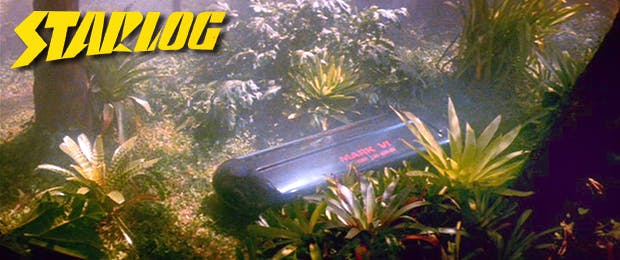
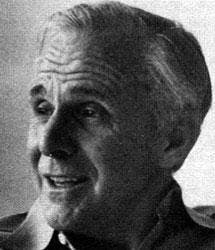
They're usually at the beginning. And as we employed them on articles published in Starlog Magazine, they were there to capture your attention. Ideally, a title should grab you, arouse your curiosity, maybe make you laugh (though not cry), somehow interest you. Their whole purpose is to entice you, to persuade you, to make you read that story. Let me demonstrate. Turn on the Anecdote Machine for a Title Sequence! Engage!
Montage of images set to spritely music. On my first day of work at Starlog (in October 1982), I showed up to a mostly clean desk. But there was a "slush pile" of unsolicited manuscripts that hadn't been evaluated by my predecessor as Managing Editor (Susan Adamo). Close-up on my expression of chagrin. So, I started in and tore open an envelope from UCLA college student Lee Goldberg. Cut to his submission, "The Man Who Killed Spock," falling out onto the desk. I took one look at his title. Hooked! This was, I should explain, an interview with Star Trek II screenwriter Jack B. Sowards, and it lived up to the promise of its provocative title as a fascinating read. I recommended to Editor Howard Zimmerman that we buy it and we did; it was Goldberg's first professional sale, published in Starlog #67. This began his prolific stint contributing to Starlog that eventually led Goldberg to a career as a TV writer-producer (Diagnosis Murder, Martial Law, etc.) and as a bestselling novelist (the Monk mystery books, recent collaborations with Janet Evanovich starting with the terrific The Heist). And all that from one inspired story headline!
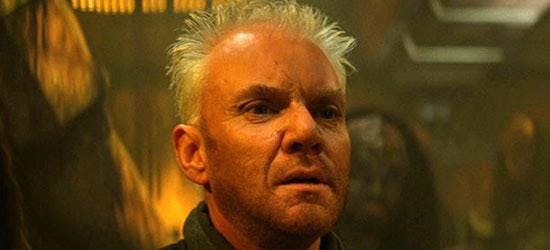
Like many titles, it's a little misleading. No actual murder was involved. In a 1984 interview, Trek movie series producer Harve Bennett told me on the record that he had rewritten Sowards' Khan screenplay (Bennett has a "Story by" credit on the picture). Years later, Trek II director Nicholas Meyer, a noted screenwriter himself, admitted to also doing script revisions. And, of course, Leonard Nimoy had agreed to his character's demise. So, perhaps we should have expanded that piece to include them and made it "The Men Who Killed Spock." And, you know, a good title bears repeating, and when Ian Spelling interviewed Malcolm McDowell 12 years later about Star Trek Generations (for #213), rest assured that we called that story "The Man Who Killed Kirk." End Title Sequence.
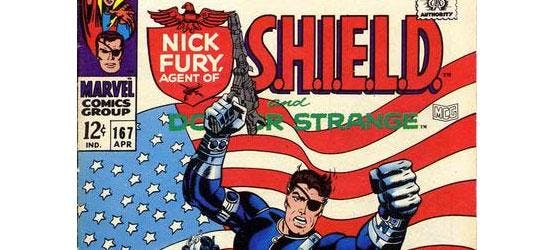
I had learned a certain amount of headline-making expertise while working for Mediascene Prevue Editor-Publisher Jim Steranko. For each article published by Prevue (which covered "tomorrow's entertainment"), I spent about an hour filling one entire sheet of yellow legal paper with potential story titles plus blurbs (a.k.a. decks, the copy blocks beneath a headline), contents page wordage and coverlines (the "sell copy" seen on magazine covers). The goal of this exercise in overkill: to give Steranko as many different possibilities as I could. Steranko -- a legendary Marvel Comics writer-artist best known for his innovative Nick Fury, Agent of S.H.I.E.L.D. comics, his Shadow paperback covers and the pre-production art that helped "sell" Raiders of the Lost Ark -- was famously perfectionistic and hard to please. He would select his favorite(s) from my yellow sheet nominees or meld two of its phrases into one or, liking none, would devise his own. It was good training for the title wars I would wage for decades.
However, I did realize that my very first two-four title suggestions were, instinctively, the best. So, when I joined Starlog, I provided Zimmerman with fewer choices, just three or four titles and blurbs per story. And after I became Editor, my "Zorro's Fighting Legion" of Managing Editors (a dozen strong over the years!) would routinely offer up one-three potential title and blurbs for me to make a final selection or to spurn them all and invent my own. I like to think that I could always recognize a good title when I saw it and would go with it, no matter whose idea it originally was. It didn't, I pragmatically accepted, actually have to be, as Daffy Duck rants, "mine, all mine."

Hopefully, a title will match the accompanying story in tone---whether seriously dramatic, light-hearted humorous or somehow ominous. I like wordplay, headlines that riff off of some previous project (be it movie, TV show, book, song or episode title), relevant puns or a quote from the interview. Fewer words (two to four) are better (allowing an article's layout designer more space to make them larger and distinctive).
Now, after three decades of experience, I sure can talk your pointy Vulcan ears off about all the minutiae of magazine editing ("Lemme tell ya about semi-colons! Why, in my day, we used a semi-colon once or twice in 'most every article; it was just to show we knew how.") Still, the crafting of titles is a topic that fascinates me, because it's, basically, trying to sell you something. I want to lure you into reading that story any which way I can.
At this late date, I mostly can't recall who came up with which title---whether writer or (normally) one of my Managing Editors or me. We actually ran pre-publication "contests" on some stories and everyone proofreading the piece (i.e. editors, interns, writers) voted on their favorite among nominated semi-finalists, all in an effort to pick the "perfect" title for every article. We often failed. But, it was fun trying.
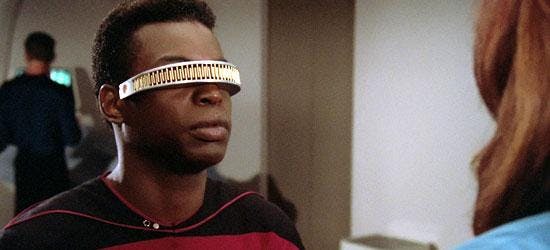
Some of my writers were just no good at it. Since I frequently joshed with Marc Shapiro about his mundane story titles, it seems permissible to reveal his routine suggestion, say, for an issue #162 cover story: "LeVar Burton Interview." We editors barely did any better than that, though, settling on calling it "Technical Expertise." Ironically, there was a far finer title lurking on that issue's Contents Page (usually written by me just a day or two before the last shipment of pages to the printer because contents are rarely final until then): "View from the VISOR." With 20-20 hindsight, we shoulda used that one on the article, but the Burton story was undoubtedly already at the printer and couldn't be altered. A later Burton piece by Spelling in #238 had a better title: "Eye Contact."

Writers do come up with great titles. My favorite example: Lynne Stephens headed her #190 profile of Daniel Davis, the Holodeck's Professor Moriarty, "A Study in Starlight." How elementary! And absolutely perfect since it invokes Sir Arthur Conan Doyle's classic Sherlock Holmes yarn "A Study in Scarlet," holographic life carved in light and, even (think about it!), Trek stardom.
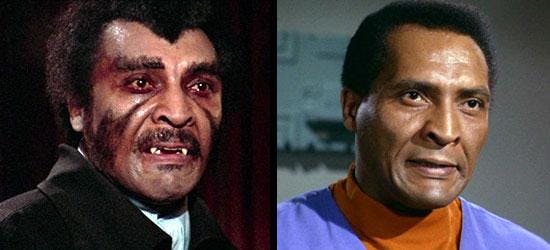
I've continued to exercise (and exorcise) my title-making skills on these Starlogging essays (with, heads up, my titles frequently but not always used so far). The object for me isn't just to get hits, but to be as on point as possible. Take the one I gave my 1974 encounter with William Marshall (who portrayed Blacula in the movies and Dr. Daystrom, the genius designer behind "The Ultimate Computer" on TOS): "Horror of Blacula." Of course, it's a play on a past project, Horror of Dracula, Christopher Lee's terrific first film as Count Dracula (Blacula's inspiration, natch); it sounds like it might be the genuine name of a third Blacula flick (only two were made: Blacula and Scream, Blacula, Scream!). But "Horror of Blacula" could also refer to the racism Marshall first confronted as a young actor... to the nervous, fumbling manner in which an amateur college student journalist (i.e., me) faced that imposing Shakesperean... and to the ultimate fate of our resulting interview. Multiple meanings! I love when that happens because it gives you, the reader, the option to interpret it as you will.
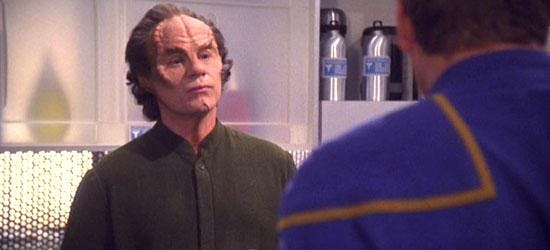
Finally, in search of examples, I've delved into a couple hundred Starlog back issues (really!) and unearthed a random dozen Trek story titles which reverberate today (as noted, no telling who wrote what headline): "The Forgotten Captain" (ST:TMP's Stephen Collins, interview by Tony Timpone, #104), "Burning Rubber" (Trek makeup wizard Michael Westmore, by Joe Nazzaro, #311), "Desperately Seeking Saavik" (Robin Curtis, by Bob Greenberger, #116), "Collective Soul," (Jeri Ryan, Spelling, #273), "I Married Spock" (Arlene Martel of "Amok Time," by Pat Jankiewicz, #291), "Where Roams the Traveler" (Eric Menyuk, by Desire Gonzales, #137), "His Ferengi Nature" (Max Grodenchik, Nazzaro, #244), "The Gamesters People Play" (Gene Nelson, who directed "The Gamesters of Triskelion," Jankiewicz, #180), "Our Beloved Uhura" (Nichelle Nichols, by Dan Dickholtz, #296), "Tomorrow's Story" (TOS writer John T. Dugan on why he used a pseudonym on "Return to Tomorrow" and how his credit went missing for years, by Bill Florence, #194), "The Universe Beneath His Heel" (Todd Bryant, who portrayed Klingon Captain Klaa in Star Trek V, by Kris Gilpin, #139) and "Playing Doctor" (John Billingsley, Spelling, #322).
They're all different, but all 12 of them would, I hope, intrigue you in some way and make you want to read those stories. End Titles.
David McDonnell, "the maitre’d of the science fiction universe," has dished up coverage of pop culture for more than three decades. Beginning his professional career in 1975 with the weekly "Media Report" news column in The Comic Buyers’ Guide, he joined Jim Steranko’s Mediascene Prevue in 1980. After 31 months as Starlog’s Managing Editor (beginning in October 1982), he became that pioneering SF magazine’s longtime Editor (1985-2009). He also served as Editor of its sister publications Comics Scene, Fangoria and Fantasy Worlds. At the same time, he edited numerous licensed movie one-shots (Star Trek and James Bond films, Aliens, Willow, etc.) and three ongoing official magazine series devoted to Trek TV sagas (The Next Generation, Deep Space Nine, Voyager). He apparently still holds this galaxy’s record for editing more magazine pieces about Star Trek in total than any other individual, human or alien.
Copyright 2014 David McDonnell
